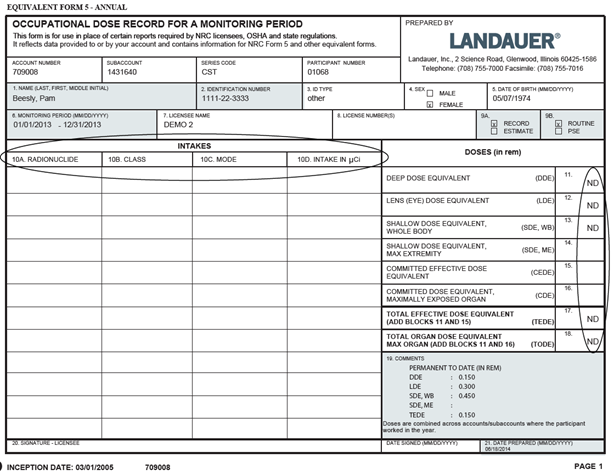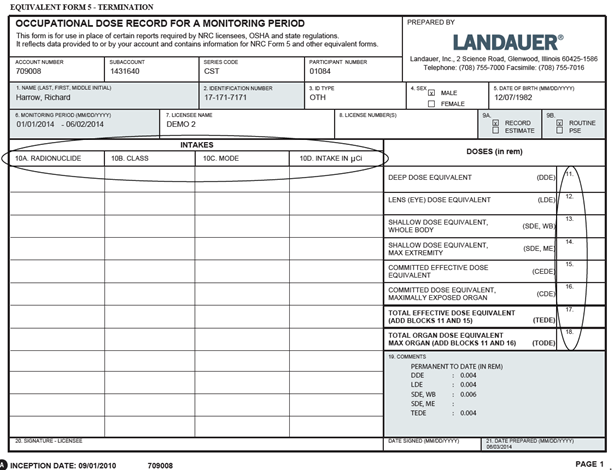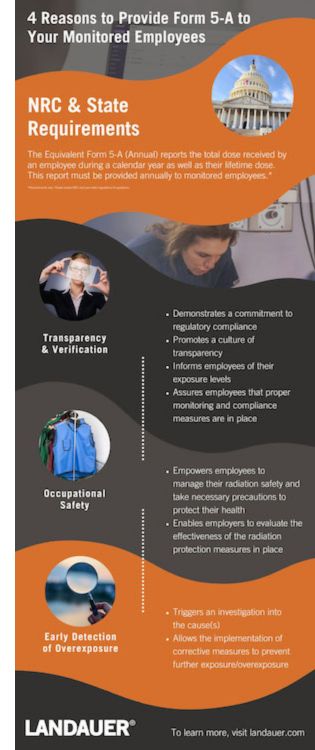
The Equivalent Form 5 - Who Needs One?
The Equivalent Forms 5-A and 5-T are essential (and often required) documents used in radiation safety programs to track and report radiation exposure. Here's an overview of these forms and who needs them.
Equivalent Form 5-A (Annual):
The Equivalent Form 5-A (Annual) reports the total dose received by an employee during a calendar year. This report must be provided annually to monitored employees and can be generated after the close of each calendar year (or can also be generated quarterly upon request). The Equivalent Form 5-A also includes the employee’s lifetime dose. It is an "equivalent" form resembling the U.S. Nuclear Regulatory Commission (NRC) Form 5.
If a LANDAUER customer is signed up for this service, the Form 5 reports are generated automatically each year. They are available for viewing in myLDR, and participants can access them through the Individual Dose Review (IDR) feature in myLDR.

Equivalent Form 5-T (Termination):
The Equivalent Form 5-T (Termination) provides the dose history for an employee during their last year of monitoring at a specific location. The form also displays the employee’s lifetime dose. It is another "equivalent" form similar to the NRC Form 5.
If the dosimetry account is set up to receive these reports, they are generated automatically, 45 days after the employee terminates employment or work involving ionizing radiation exposure. At the request of the customer, the report can be generated by LANDAUER on demand.
To ensure an employee does not exceed established dose levels/limits during the current calendar year, a new employer can request the Equivalent Form 5-Termination report (i.e., the radiation dose history) from the previous employer. However, dose records are considered medical records and the employer must obtain specific written consent for their release including but not limited to:
- The name and signature of the employee authorizing the release of medical information
- The date of the written authorization
- The name of the individual or organization that is authorized to release the medical information
- The name of the designated representative (individual or organization) that is authorized to receive the released information
- A general description of the purpose for the release of the medical information
Check your state’s regulations as they may be more restrictive. [See Title 10 Code of Federal Regulations (CFR), Part 19.13 and Title 40 CFR, Part 1910.1020(c)(12)].

NOTE: A brief explanation of the form’s purpose and a legend are present on the back of the Equivalent Forms 5-A and 5-T (i.e., on Page 2). Dose results for both forms are reported in rem and include, Deep Dose Equivalent (DDE), Lens (eye) Dose Equivalent (LDE), Shallow Dose Equivalent, Whole Body (SDE, WB), Shallow Dose Equivalent, Max Extremity (SDE, ME), Committed Effective Dose Equivalent (CEDE), Committed Dose Equivalent, Maximally Exposed Organ (CDE), Total Effective Dose Equivalent (TEDE), and Total Organ Dose Equivalent, Max Organ (TODE). If an “ND” is noted in any box, it is likely the participant had minimal exposure throughout the year. Minimal exposure is designated with an “M” on other Landauer reports. For example, this is < 10 µSv (1 mrem) for the Luxel+ dosimeter. “ND” stands for non-detectable. Non-detectable exposures are below the lowest limit of accurate detection.
Who Needs to use Form 5?
The NRC, the Occupational Safety and Health Administration (OSHA), and state radiation safety regulations require employers to provide either the NRC Form 5 or the Equivalent Form 5 annually to employees. Employers are also required to provide these forms to employees who request their dose report, and inspectors will ask how these are distributed and what is your process to ensure that every applicable staff member received this report as required by the regulations.
There is an exception to providing employees annual dose reports (i.e., the NRC Form 5 or Equivalent Form 5-A) outlined in Title 10, CFR, Part 19.13 – Notifications and Reports to Individuals. It states that the annual dose report only needs to be provided to the monitored individual if their occupational dose exceeds 1 mSv (100 mrem) total effective dose equivalent (TEDE) or 1 mSv (100 mrem) to any individual organ or tissue. It's important to check your state's regulations to ensure they align with this exception before limiting the distribution of annual dose reports.
As a best practice, it is recommended to provide all employees with either the NRC Form 5 or the Equivalent Form 5. This practice assures individuals that their dose is being monitored and recorded. It promotes accurate recordkeeping, which is essential for legal and regulatory reasons. For example, if disputes or claims arise related to radiation exposure, having comprehensive and up-to-date dose records is crucial in establishing a factual basis for investigations, insurance purposes, or legal proceedings.
In addition to regulatory compliance, the provision of these forms offers other benefits including:
 Transparency and Verification:
Transparency and Verification:
Providing dose records to employees annually and upon termination demonstrates a commitment to regulatory compliance, promotes a culture of transparency, and informs employees of their individual exposure levels. It assures employees that proper monitoring and compliance measures are in place.
Occupational Safety:
Ionizing radiation can pose health risks, especially with chronic exposure or at higher doses. Providing employees with their radiation dose records informs them about their level of radiation exposure. It empowers them to manage individual radiation safety and take necessary precautions to protect their health. The periodic review of radiation dose results enables employers and radiation safety professionals to evaluate the effectiveness of radiation protection measures in place.
NOTE: Everyone is a safety officer and obligated to ensure personal safety and the safety of those around them. Providing employees with information about their radiation dose also supports the continuous improvement of workplace radiation protection practices.
Early Detection of Exposure/Overexposure:
Regularly monitoring radiation dose results also enables the early detection of excessive radiation exposure. If an employee's dose exceeds established limits, it triggers an investigation into the cause(s) and allows the implementation of corrective measures to prevent further exposure/overexposure.
Training and Education:
The availability of radiation dose records facilitates radiation safety training and education programs. Employees can compare their dose results with established exposure levels/limits, empowering them to make informed decisions regarding protective measures and adhere to safe work practices.
To add Form 5 reports to your account, contact LANDAUER at 800-323-8830 ext. 1.

